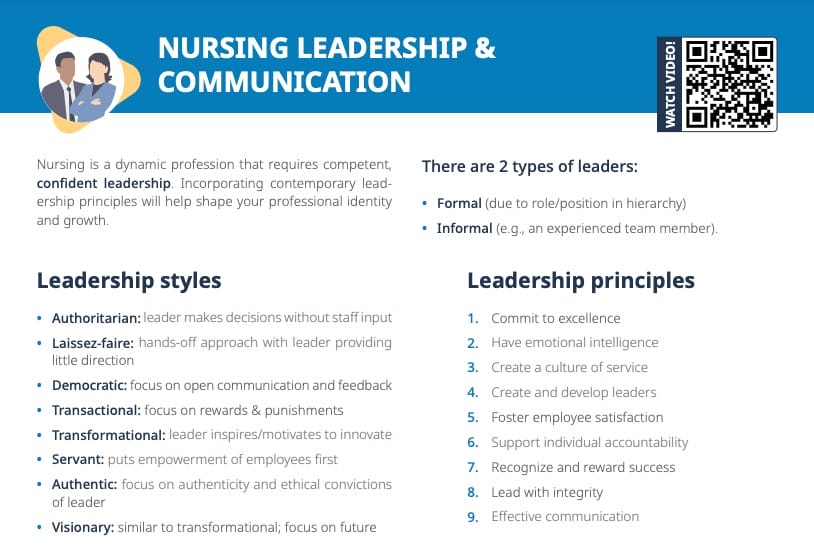The importance of feedback in nursing
Types of feedback
The 3 main purposes (or types) of performance feedback are:
- Reinforcing good behavior
- Correcting undesired behavior
- Coach and improve upon behavior
Goals and benefits of nursing feedback
In a clinical setting, all team members continuously giving and receiving feedback plays a big role in ensuring high-quality patient care, professional growth, and a collaborative team environment. Examples of specific benefits include:
- Patient safety and quality assurance (mistakes being addressed)
- Refining skills and professional growth (lifelong learning through feedback, identify areas for improvement)
- Encouraging accountability
- Role clarity (feedback helps reflection on own scope of responsibility)
- Improved teamwork (constructive feedback helps trust among team, promotes collaboration)
What is constructive feedback in nursing?
Nursing feedback channels
In clinical nursing practice, feedback can flow in different directions:
- Instructors or staff nurses give feedback to nursing students.
- Nurses can give feedback to each other.
- Interdisciplinary feedback (pharmacists/doctors/nurses giving each other feedback)
- Patients and families to nurses
- Quality improvement to nurses
- Nurses to managers/leadership
How to give feedback constructively
To reinforce good behavior:
Don’t leave it at “nice job” – be specific about which behavior was well done, and why it had a positive impact.
To correct undesired behavior:
- Always start with seeking understanding and asking genuine questions.
- Then, discuss the exact nature and the impact or outcome of the undesired behavior.
- Work with the receiver of the feedback on identifying an alternative behavior that would work better, again emphasizing the “why.”
- Follow-up is essential.
To improve and coach:
- This type of feedback should be given similarly to corrective feedback.
- The suggested alternative actions build on the behavior that was already shown.
Best practice for providing feedback to a nursing student in the clinical setting
For nursing students, receiving constructive feedback in the clinical setting is vital for learning and professional development.
Here’s a selection of best practices to follow when giving feedback to students:
- Give feedback promptly: as soon as possible after the event while it is still fresh in the student’s mind
- Encourage questions and discussion: provide time for questions; student can self-evaluate first
- Adjust feedback to student’s level: according to student’s stage in training and expected competencies, and fitting to learning objectives and performance standards
- Be specific and objective: sticking with facts and direct observations with specific examples instead of vague generalizations
- Be constructive: provide suggestions, show correct way, set concrete goals for improvement
- Ensure student stays receptive: start and end conversation with positive reinforcement, choose suitable place for conversation, focus on behavior instead of personality
Tip: Documenting feedback given helps keep track of improvements and progressions and can be a reference for future evaluations.
What to do when feedback is not taken
When feedback does not enhance improvement, asking specific questions to understand the disconnect becomes even more important than when giving corrective feedback initially.
- Check if the receiver understands the agreed upon behavior change or action step
- Identify the reasons why that goal was not met
- Clarify whatever is unclear
Tip: There are other ways of influencing someone toward better behavior outside of simply telling them. These include:
- Offer help/working on tasks together
- Spend some time to concretely map out how to do the action better
If resistance in accepting feedback is met with a team member, ask the nurse manager for assistance, or inquire to HR for help.
How to get patient feedback
Common ways how patient feedback is gathered include:
- Patient satisfaction surveys
- Focus groups with patients about specific topics
- Comment cards/boxes in patient rooms or common areas
- Interviewing patients during their stay
- Routine nursing rounds
- Exit interviews
- Observing patient–nurse interactions
- Social media and online reviews
How to respond to bad patient feedback
Responding to negative patient feedback is important for maintaining trust, demonstrating commitment to quality care, and identifying areas for improvement.
Here’s a few tips for how to respond to bad patient feedback:
- Listen. Allow the patient to share their feedback without interruption and ask for clarifications. (“Thank you for sharing.”)
- Stay calm. Even if you feel defensive or upset, remain composed and avoid becoming confrontational or dismissive.
- Express empathy. (“I understand why you’d be upset.”)
- Validate and acknowledge the patient’s experience without being dismissive. (“I see how this could have been a negative experience for you.”)
- Do not blame others. (“I apologize for the experience you had.”)
- Offer solutions and follow through by implementing and/or sharing the feedback with the team and supervisors. (“I’ll share this with our team to ensure it doesn’t happen again.”)
Nursing peer review feedback: examples
Nursing peer review is a process by which nurses evaluate the performance and practice of their colleagues to ensure the standards of care are met and to promote continuous professional development. It is grounded in the principles of quality assurance, professional growth, and accountability.
Examples of positive feedback:
- “I’ve noticed that you always maintain strict aseptic technique during wound dressing. It sets a great example for the team.”
- “Your documentation is always thorough and timely, ensuring continuity of care.”
- “Your collaboration with the physiotherapy team to ensure post-op patient mobility was exemplary. It led to a quicker recovery for the patient.”
Constructive feedback examples:
- “I found some inconsistencies in your charting regarding pain assessment. Let’s review the standard pain assessment tools to ensure accuracy.”
- “I’ve observed that you frequently check your phone during patient care activities. It might be perceived as inattentiveness by patients.”
- “I’ve observed that sometimes during handovers, you speak very quickly, and important details might be missed. Slowing down a bit could ensure clearer communication.”
